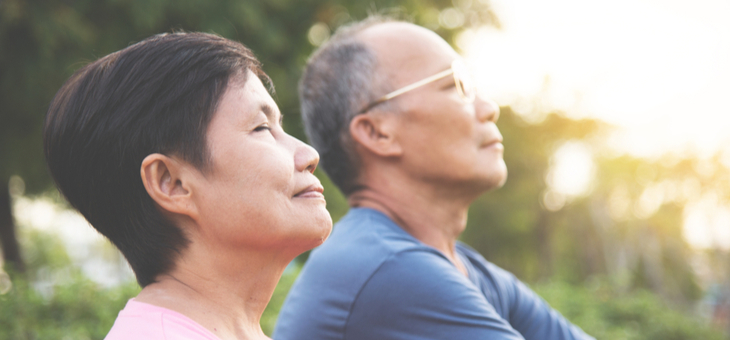Breathing has always been linked to the energy of life. Whether it’s the first breath of the newborn, the Christian tradition of God breathing life into Adam, or the Eastern traditions of yoga and martial arts that explicitly cultivate life energy through breathing practices.
The main problem with breathing is that it is so commonplace that we don’t notice just how powerful it can be as tool for managing mood and enhancing energy.
Different styles of breathing change with different moods and emotional states. When people are anxious, they often tend to breathe high in the chest, often with a gasping quality, holding the breath a little as if frozen. When asked to take a deep breath it is as if they are trying to cram a bit more into the top of the chest. For some anxious people it is like a mild panic, and the breath is high in the chest but faster. When people are depressed, they often sigh the breath out and the inhale is restricted. Although an exaggeration, it is often the case that anxious people don’t breathe out and depressed people don’t breathe in.
This means that the breath can be used to rapidly calm if anxious or lift energy. Breathing is calming if it is low (breathing lower into the lungs using the diaphragm), slow, and by extending the exhale. A simple calming breath is just to breath in through the nose then make a tiny opening in the lips (like breathing through a straw) and let the breath seep out slowly, like a slow leak. Another calming breath is to breathe in and out through the nose while drawing the air deep into the lungs (using the diaphragm), then extending the exhale by squeezing in the belly – let the belly be passive on the inhale.
To lift mood and energy a great breath is to breathe in slowly and fully, then passively let the breath out. A range of recent research suggests it brings the body into balance if you can slow the breath down to about five or six seconds in and five or six seconds out, but you should never strain, so just go as slowly as feels comfortable.
As well as changing with specific emotions, our breathing patterns can change long term. After stressful events, we can have a tendency to over-breathe or under-breathe, as the body does not always reset itself properly. Best breathing is about balance and responding to the needs of the moment. You need to pump up your breathing during exercise, but over-breathing at rest links with stress and anxiety. Some research suggests that many older people under-breathe, and that this can link with poor health and low energy. Having a regular breathing practice is like a mix of exercise and meditation, and a nice practice is to breathe in slowly and fully, then let the air out passively to start and then gently squeeze out a bit more at the end by drawing in the belly – always gently and listening to your own body, so stopping if you have any discomfort. Doing several rounds like this tends to have a peaceful, revitalising effect, gently joyous.
How aware are you of the way you breathe? Do you find yourself taking shallower breaths when you become anxious?
Dr Greg Smith is a psychologist and the author of Purposeful Breathing, which is available through Exisle Publishing.
If you enjoy our content, don’t keep it to yourself. Share our free eNews with your friends and encourage them to sign up.
Related articles:
https://www.yourlifechoices.com.au/lifestyle/leisure/how-to-turn-succulents-into-art
https://www.yourlifechoices.com.au/health/wellbeing/how-to-stop-slouching
https://www.yourlifechoices.com.au/health/your-health/how-to–meditate

